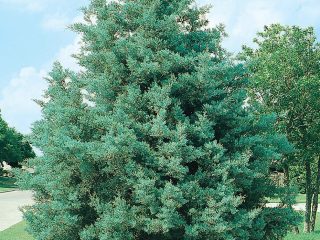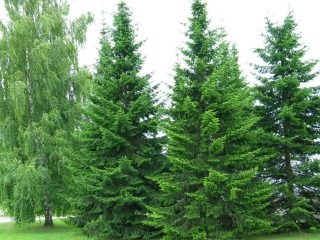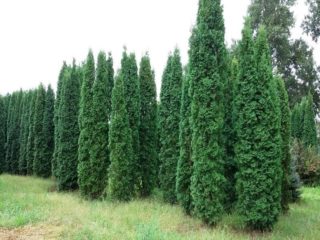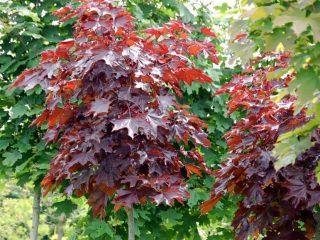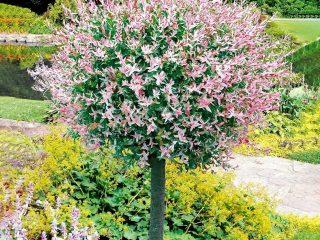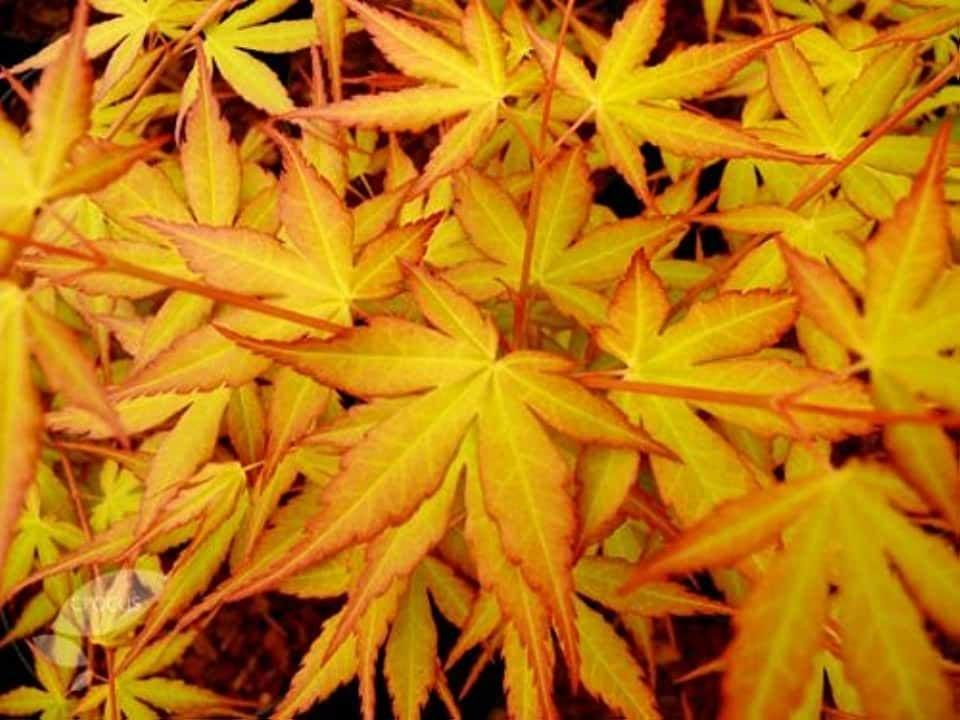Content
In some regions you can find truly outlandish plants. They are found both in the north and in the south. The vast country has sheltered millions of cultures that amaze the imagination with a variety of shapes and shades. Chinese ash (Ailanthus) is one such plant. In addition to its bizarre appearance, it has a useful composition, which has made it incredibly valuable in pharmaceuticals and industrial production.
Description of the Ailanthus tree
Chinese ash is a tall tree, reaching 35 m in height. At the same time, the diameter of the trunk is only 50 cm. The wood is covered with growths resembling notches. There are few such formations, mostly the bark is smooth.
Being a representative of the Ailanthus genus, Chinese ash has inherited the typical structure of its shoots. The foliage on the branches is very dense, growing more than 55 cm in length - which is quite a lot for most trees. The leaves end with several blunt ends. The plates have a dark green tint. They are matte on the back side and glossy on the outside.

If you touch a leaf of a Chinese ash tree, an unpleasant odor will emanate from your hand.
Ash is a dioecious crop. This means that the flowers are self-pollinated. The buds are presented in green colors, hanging on a panicle 15 cm long. Budding occurs in mid-late summer. If conditions are favorable, a second wave begins in the fall.
Chinese ash has an extensive root system, which allows it to withstand gusty winds. The culture grows in the south and regularly needs water. This is the reason for the large diameter of the roots.
Ailanthus has the highest frost resistance
Ailanthus can be called a winter-hardy crop, because it can withstand negative temperatures without problems. When the thermometer drops to -25 degrees, it is better to cover the Chinese ash tree. The frost resistance zone of the highest ailanthus is 4. It is suitable for planting in the Central region.
Composition and properties
Chinese ash is a very valuable plant. Its bark contains useful substances: alkaloids, essential oils, carotene, vitamin C and others. Eating shoots benefits the entire body and can even relieve some ailments.
Methods of application
Not only the wood, but also the leaves of Ailanthus are valuable. Man uses the plant for the following purposes: in medicine, in gardening and in production.
In medicine
Since the shoots of Chinese ash cope well with inflammation, medicines are prepared on their basis. Properly prepared decoctions have an antiviral effect.In folk medicine, ailanthus is an indispensable plant and is always at hand for experienced healers.
With the help of Chinese ash, malaria is treated, and also gets rid of internal parasites - worms. Wood is an antiseptic. It is added to medications to help cope with skin diseases.
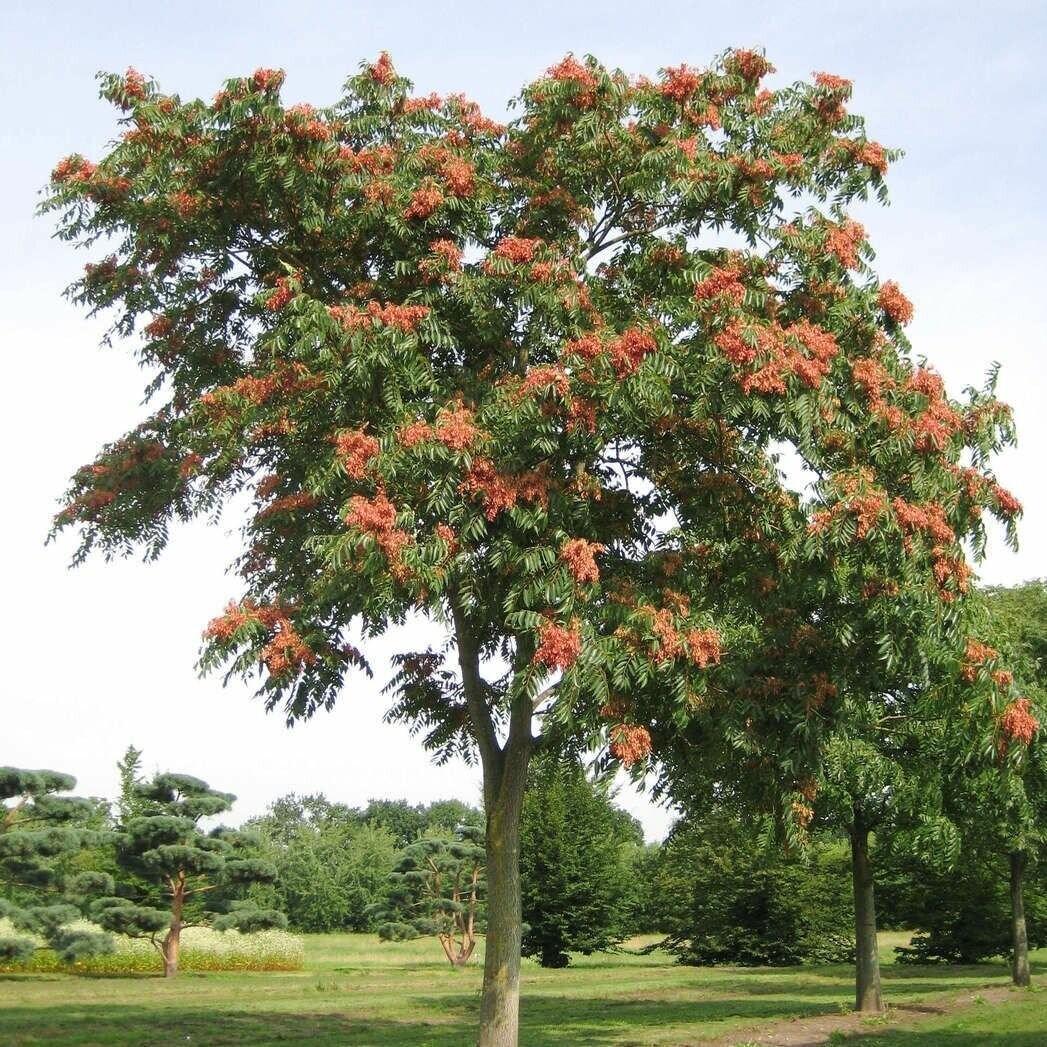
With the help of Chinese ash, positive results are achieved in the treatment of lichen
Based on the shoots of Chinese ash, tinctures are prepared to cleanse the gastrointestinal tract. The product relieves diseases of the stomach and intestines. Preparations created from bark extract are effective in treating gallbladder damage and in the treatment of hemorrhoids.
In gardening
The blooming Chinese ash tree will impress any guest, so the tree is grown everywhere - in the Moscow region, in the northern zone, in the south. Plantings are located in open clearings, where the plant looks more decorative.
In production
In addition to pharmaceuticals, Chinese ash is used in furniture production. The bark is highly durable; cabins and airplane cabins are even lined with it. Sometimes souvenirs are made from ailanthus, but they are expensive.
The wood is used to produce paper of the highest quality. The juice is also valuable - it is used to prepare oil paints and embalming products.
Possible harm and contraindications
Preparations from Chinese ash should be taken in doses and carefully. Under no circumstances should you self-medicate. In the wrong hands, the plant will do more harm than good.
In general, there are no contraindications for medications.The exception is allergy sufferers who react acutely to the content of certain substances. Allergies are not always congenital. Breastfeeding mothers and women at any stage of pregnancy are also exempt.
Landing rules
Chinese ash is a plant that requires little care if it is in the right conditions. The annual growth is from 200 to 300 cm. The plant is resistant to external conditions, it can be planted in the sun or in light shade. The tree is also unpretentious in terms of soil quality.
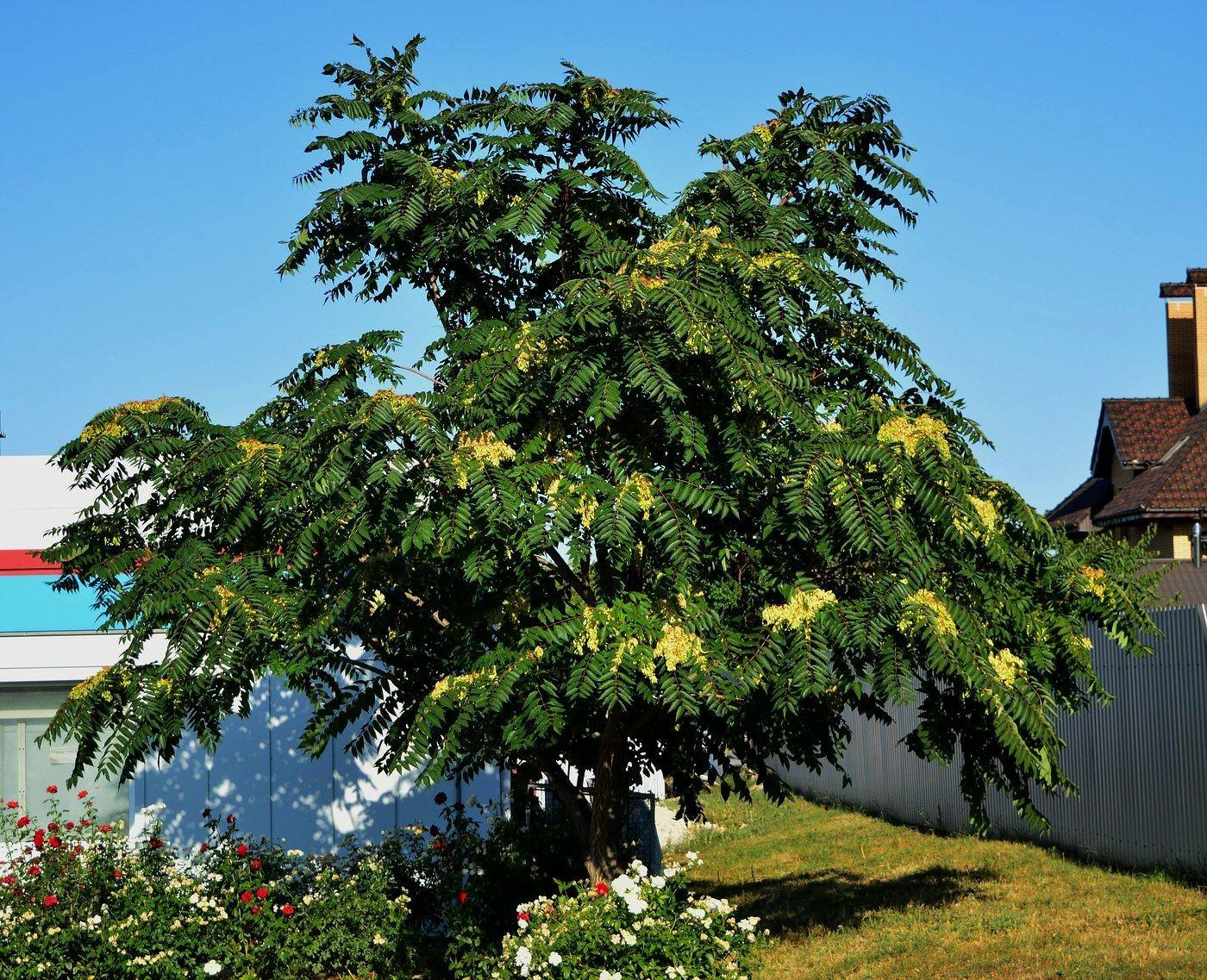
The best option for planting Chinese ash is a clearing flooded with light or partial shade, where the influence of winds is reduced by fences
All points should be taken into account in advance. Chinese ash does not like transplanting. Complex fertilizers are added to the planting hole. You can add ash, rotted manure and minerals. Products such as Kemira and Kristalon perform well. The diameter of the hole should be sufficient for the seedling: they are guided by the roots and add a few centimeters of reserve.
Features of care
Chinese ash does not require much care. Whether the soil and climate are suitable for the plant is judged by its annual growth. If it is small, conditions need to be improved. If completely neglected, the tree will barely reach 14 m and will not be able to develop further. Life expectancy will be shortened.
Fertilizers are applied twice a year - in the spring, when the Chinese ash tree awakens from sleep, and in the fall, when, on the contrary, it prepares for hibernation. Azophoska and other complex additives are used. They try to use not only organic matter, but also minerals.
The tree is moisture-loving, which is what basic plant care is based on. There should be no sediment or dirt in the water. Water when the liquid is warm enough, since cold has a bad effect on the health of the roots. To ensure that moisture spreads deep into the ground, the tree trunk circle is dug up every season.
Growing Chinese ash in the northern regions is difficult. When planting in Siberia and the Urals, the tree must be prepared for winter. The trunk is hilled up, the young seedlings are covered (if the plant is an adult, simply hilling up is enough). To reduce the risk of frostbite, plantings are located in places protected from drafts.
Reproduction methods
Ailanthus is cultivated using seeds and seedlings. Seeds become suitable for work if they lie in a dry and ventilated place. Seed material remains viable for two years.
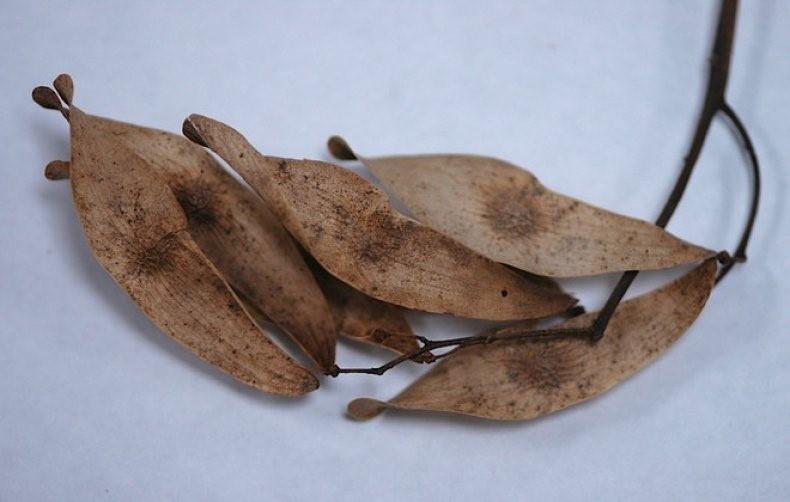
The day before planting, Chinese ash seeds are soaked in warm water.
The best time for sowing is in mid-spring, when the soil is abundant in moisture. The seeds are deepened by 30 mm. Gardeners rarely follow this method, since it takes a long time and is not always effective. Chinese ash seeds have poor germination - about half of the samples develop.
It is easier to propagate Ailanthus if you have a ready-made seedling. In this case, it is possible to avoid the risk that the culture does not adapt.In addition, growing a tree is quick and does not require constant supervision from the owner.
The hole for planting is prepared according to the instructions presented above. The seedling is placed in the center, the roots are straightened, covered with soil and watered. The first hydration is very important, it should be plentiful. After 20 days, the seedling will adapt to the new conditions and begin to grow.
Diseases and pests
Before the arrival of cold weather, the trunk should be wrapped with agrofibre. Some people use cardboard as a covering material; it is covered with a layer of roofing felt. Such protection will not only provide warmth in winter, but will also prevent damage by rodents.
As for small insects, you don’t have to worry about Chinese ash. Even ants do not touch the strong bark, and the caterpillars are repelled by the fragrant foliage.
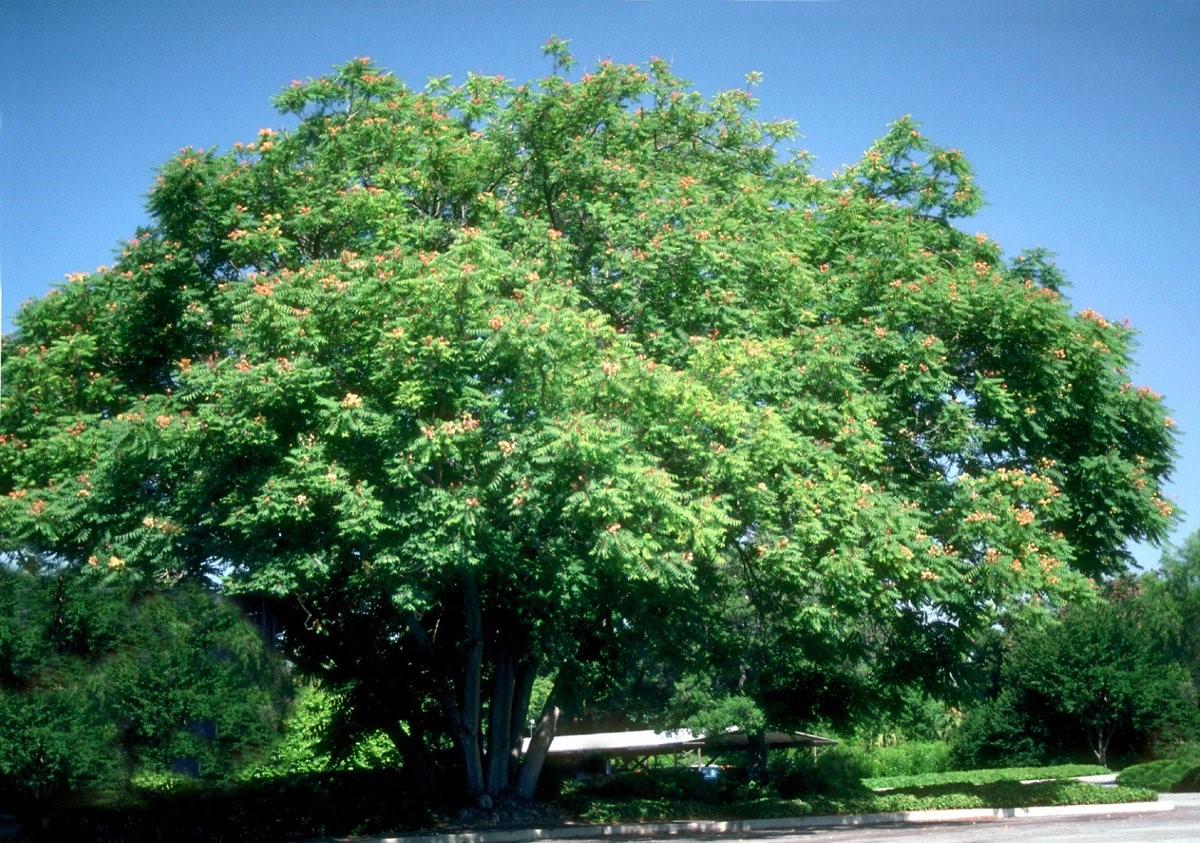
Chinese ash is very easy to care for if you devote a little time to it every day - at least for inspection
Growth rate may be affected by disease. A crop can become sick due to frequent drafts and sudden changes. As a preventative measure, young seedlings are sprayed with fungicides. Mature trees do not need treatment.
Conclusion
Chinese ash is an easy-to-care crop that has gained fame in the East. From there it was exported to Russia and has since become popular among designers and industrialists. Ash wood is quite valuable: it is used to create medicines, durable furniture, paper, and paint. You can grow a seedling in almost any soil.

